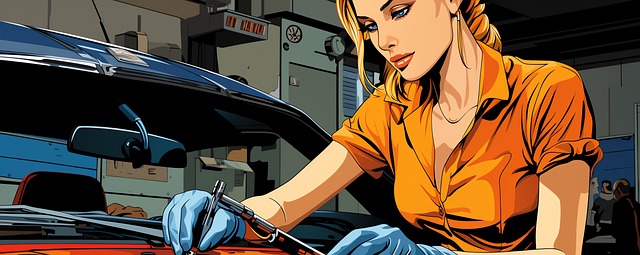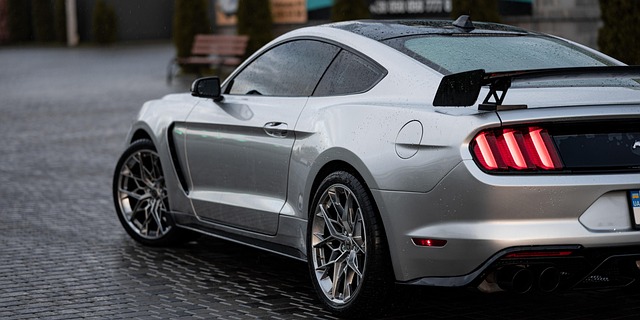Mastering OEM Certified Collision Repairs: A Comprehensive Guide
OEM certified collision repair is essential for top-quality Mercedes-Benz repairs, adhering to manuf…….
Welcome to an in-depth exploration of a transformative process that is reshaping the automotive industry—OEM (Original Equipment Manufacturer) certified collision repair. This innovative approach to vehicle restoration combines cutting-edge technology, meticulous craftsmanship, and a deep commitment to environmental sustainability. In this comprehensive article, we will navigate the intricacies of OEM certified collision repair, uncovering its global impact, economic significance, technological strides, regulatory landscape, and much more. By the end, readers will grasp the profound influence this method has on shaping the future of automotive care.
Definition:
OEM certified collision repair refers to a specialized process where vehicles, after sustaining damage, are restored to their original manufacturer specifications using approved parts and methods. This meticulous approach ensures that the repaired vehicle retains its pre-accident condition, quality, and safety features.
Core Components:
Historical Context:
The concept of OEM certified collision repair has evolved over several decades, driven by advancements in automotive technology and a growing emphasis on safety and quality. In the past, after-market parts and less stringent repair methods were common, often leading to subpar results. However, with increasing consumer demand for high-quality repairs and manufacturers’ focus on vehicle performance and safety, OEM certified collision repair gained prominence. Today, it is recognized as a standard of excellence in the industry.
Significance:
This certification ensures that vehicles are repaired to the highest standards, maintaining their original design, safety features, and resale value. It also fosters trust between consumers, insurance providers, and repair facilities, promoting transparency and peace of mind.
International Influence:
OEM certified collision repair has a global reach, with adoption across North America, Europe, Asia-Pacific, and emerging markets. Each region has its unique dynamics, but the underlying principles remain consistent: quality, safety, and environmental sustainability.
Regional Trends:
Market Dynamics:
The global collision repair market, driven by factors like vehicle ownership growth, accidents, and natural disasters, reached a value of USD 423.7 billion in 2021 (Source: Grand View Research). OEM certified collision repair, as a premium service, contributes significantly to this market’s revenue, especially with increasing consumer expectations.
Investment Patterns:
Automotive manufacturers are investing heavily in training programs and setting up dedicated crash test facilities to support OEM certified repair. This trend is expected to continue as the industry shifts towards more advanced and specialized repairs.
Economic Impact:
Revolutionizing the Process:
Technology plays a pivotal role in enhancing OEM certified collision repair:
Impact and Future Potential:
These technological advancements have led to quicker repair times, reduced waste, and improved overall quality. As technology evolves, we can expect further integration of AI, virtual reality for training, and advanced sensor systems for damage assessment, promising even more efficient and precise collision repairs.
Governing Bodies:
Key regulatory bodies shaping the landscape of OEM certified collision repair include:
Regulatory Influence:
Regulations drive the industry towards adopting best practices, ensuring consumer protection, and promoting environmental stewardship. They also encourage the use of advanced technologies and eco-friendly materials, aligning with global sustainability goals.
Main Concerns:
Proposed Solutions:
Case 1: Germany’s Green Collision Repair Initiative
Germany has pioneered an eco-friendly collision repair approach, winning global acclaim. The initiative focuses on using recycled materials, efficient waste management, and advanced water-based painting technologies. This method not only reduces environmental impact but also creates a unique, vibrant finish, attracting customers seeking sustainable and aesthetically pleasing repairs.
Case 2: Japan’s Precision Repair Culture
Japan’s automotive industry is renowned for its meticulous attention to detail, and this extends to collision repair. Their precision techniques ensure minimal material wastage and perfect color match. Japanese manufacturers invest heavily in training, resulting in a highly skilled workforce that delivers consistently high-quality repairs.
Case 3: U.S.’s Disaster Repair Response
In the aftermath of natural disasters like hurricanes and wildfires, the U.S. has successfully mobilized OEM certified repair teams to assist affected communities. This rapid response involves specialized equipment, trained technicians, and coordination with insurance providers, ensuring efficient and reliable vehicle restoration.
Growth Areas:
Emerging Trends:
Strategic Considerations:
OEM certified collision repair is more than just a repair process; it is a testament to the automotive industry’s commitment to quality, safety, and sustainability. This article has explored its global impact, economic significance, technological strides, regulatory framework, and challenges. Through case studies and an examination of future prospects, we have highlighted its transformative potential. As the industry continues to evolve, OEM certified collision repair will remain a cornerstone of vehicle restoration, shaping consumer expectations and setting new standards for excellence.
Q: What sets OEM certified collision repair apart from regular repairs?
A: OEM certified repair uses genuine manufacturer parts and follows precise, standardized procedures ensuring original equipment quality and safety features.
Q: Is it more expensive than traditional repair?
A: While it may cost more initially due to the use of genuine parts, the long-term benefits include better resale value, reduced risk of future repairs, and enhanced vehicle performance.
Q: How can I find a facility with OEM certification?
A: Most reputable collision repair shops display their certifications prominently on their websites or in their facilities. Reputable manufacturers also maintain directories of certified repair centers.
Q: Are there environmental benefits to OEM certified repair?
A: Absolutely! The industry is embracing eco-friendly materials and processes, reducing waste, and minimizing the environmental impact of vehicle repairs.
Q: Can OEM certified repair restore my vehicle to its original condition?
A: Yes, that’s the primary goal. Skilled technicians use original parts and advanced techniques to return your vehicle as close as possible to its pre-accident state.

OEM certified collision repair is essential for top-quality Mercedes-Benz repairs, adhering to manuf…….

OEM certified collision repair for electric and hybrid vehicles ensures structural integrity, mainta…….

OEM certified collision repair is a specialized service that adheres to original equipment manufactu…….

OEM certified collision repair guarantees top-tier auto restoration after accidents or damage, using…….

OEM certified collision repair is a meticulous process prioritizing vehicle quality and safety post-…….

OEM certified collision repair is paramount for auto repair shops aiming to provide top-tier bodywor…….

OEM certified collision repair sets industry standards for restoring vehicles to their original spec…….